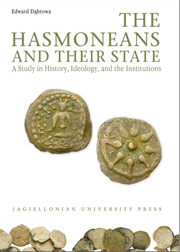Book contents
- Frontmatter
- Contents
- Introduction
- Abbreviations
- Part I Judea under the Hasmoneans (167–63 BCE)
- Part II The Institutions of the Hasmonean State
- I The Ruler
- 1 The Royal Priesthood or the Priestly Monarchy
- 2 The Priesthood
- 3 The Kingship
- 4 Succession
- 5 The Royal Family
- 6 The Court
- 7 The Capital City
- 8 The Palace and the Baris
- 9 Propaganda and Self-Presentation
- II The State
- Part III Society
- Conclusions
- Bibliography
- Index of Personal Names
- Index of Place Names
- Index of Ancient Sources
- Electrum - Volumes Published
- The Hasmonean State
7 - The Capital City
from I - The Ruler
Published online by Cambridge University Press: 05 September 2014
- Frontmatter
- Contents
- Introduction
- Abbreviations
- Part I Judea under the Hasmoneans (167–63 BCE)
- Part II The Institutions of the Hasmonean State
- I The Ruler
- 1 The Royal Priesthood or the Priestly Monarchy
- 2 The Priesthood
- 3 The Kingship
- 4 Succession
- 5 The Royal Family
- 6 The Court
- 7 The Capital City
- 8 The Palace and the Baris
- 9 Propaganda and Self-Presentation
- II The State
- Part III Society
- Conclusions
- Bibliography
- Index of Personal Names
- Index of Place Names
- Index of Ancient Sources
- Electrum - Volumes Published
- The Hasmonean State
Summary
The choice of place for the king's permanent residence, his capital, was typically determined political, strategic, economic, or even prestige-related considerations. The Hasmoneans never had to face such choice as the historical and religious tradition of the Jews made Jerusalem the only worthy location. The Hasmoneans first became involved with Jerusalem in 164, when Judah Maccabee succeeded in capturing the city and restoring the Temple to Judaic worship. During the years 152–137, they were continuously present in the city, both as high priests of the Temple and as rulers of Judea.
Jerusalem was to the Hasmoneans not just a religious capital but the center of government. This crucial role the city played could not be without effect on its layout and growth trends. The rulers' permanent residence in the capital favored its urban development and population increase. The number of inhabitants in Jerusalem likely started to rise the moment the Hasmoneans' authority over Judea had stabilized in the times of Simon and John Hyrcanus. The emergence and growth of the government's administrative institutions at the time, as a matter of course, brought to Jerusalem many high officials performing various functions at the ruler's side. Their duty to stay near him made them build residences that changed the face of the city. Unfortunately, very little archaeological evidence is available from the Hasmonean period to permit a reconstruction of such palaces. To a limited extent, this can be done based on remains of homes making up the residential quarter, revealed near David's Tower.
- Type
- Chapter
- Information
- The Hasmoneans and their StateA Study in History, Ideology, and the Institutions, pp. 130 - 131Publisher: Jagiellonian University PressPrint publication year: 2009



